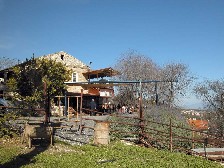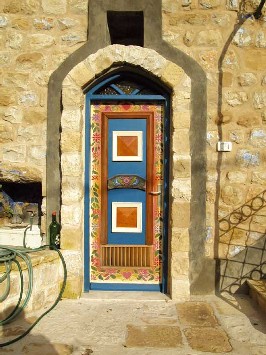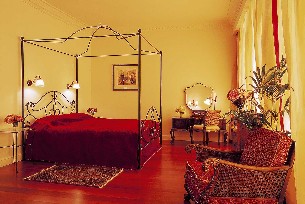|
ERETZ Magazine
|
Stayput
Safed, Rosh Pina & Hazor
Safed and its environs have always been a place
of mysticism. Second-century Jewish sages like Rabbi Shimeon Bar
Yochai, sixteenth-century mystics like Luria and Caro, and modern
hassidim have turned this area into one of the most magical in the
Land of Israel.
Mount Canaan is one of the highest mountains in
the Galilee. Its summit affords a panoramic view of the Hula Valley,
the Sea of Galilee, the mountains of the Upper Galilee, and the
Mountains of Lebanon. Clustered on its slopes are the three entities
that make up this region: Safed high up near the summit; Rosh Pina
at the bottom; and Hazor tucked away underneath the Biriya Forest.
Safed is the oldest. Probably already settled in Roman times, the
citadel of Safed was one of the biggest Crusader castles in the Land
of Israel. After the Moslems expelled the Crusaders, it even served
at certain points as the capital of the Land of Israel. In the
sixteenth century, it became famous as the city of the Kabbalists.
Rosh Pina, the cornerstone, grew out of Safed. Founded in 1875 by
Jews from Safed, it was abandoned and resettled in 1882 by Jews from
Romania who created the first Jewish agricultural settlement in the
Galilee. Today the old picturesque village is a sought-out travel
and holiday destination. A few kilometers from Rosh Pina is the town
of Hazor, which was founded in 1953. On its outskirts is the grave
of Honi the Circle maker, one of the most famous Galilean miracle
makers.
(Back to top)

Where to Dine
The best culinary option in the Safed area is
Muscat, the meat restaurant at Mitzpe Hayamim. Chef Haim Tibi, a
native of Safed, built the menu around the agricultural bounty of
Mitzpe Hayamim. The vegetables, fruits, and herbs are picked daily
from the hotel’s extensive grounds. Tibi’s menu offers a rich
variety of flavors and creatively incorporates both recipes from the
home kitchen and gourmet cuisine. (Mount Canaan, Tel. (04) 699-4555,
not kosher).
Maximillan and Fresca Zehava are two kosher options in Safed. With
an atmosphere and appearance reminiscent of an Italian piazza,
Maximillan is a pleasant place to stop for lunch. Chef Michal
Shimoni prepares dairy, vegetarian, and fish cuisine, including rich
salads featuring seasonal fruits. (General Exhibition Plaza, Tel.
077-788-2887). Fresca Zehava is a Tunisian-style eatery that has
been serving up excellent couscous and spicy pumpkin salad, among
other delicacies, for more than 18 years (26 Jerusalem Street, Tel.
(04) 697-4342).
Se’uda Began Eden is located in an old stone building on Mount
Canaan and specializes in home-style cooking (Mount Canaan, Tel.
(04) 697-2434, kosher).
(Back to top)
Lecha Dodi
The expulsion of the Jews from Spain in 1492
reverberated throughout the Jewish world. The uprooting of families,
conversions, and the Inquisition’s reign of terror revived the
debate about the meaning of Jewish existence in exile. In the years
that followed, messianic hopes were rekindled along with interest in
Kabbalah and mysticism. This coincided with the conquest of the Land
of Israel by the Turks, who welcomed Jewish settlement. In the
sixteenth century, Safed became a center of Jewish learning, to
which rabbis, sages, and mystics were drawn.
Moshe Cordovero
Born around 1522 in Cordova and ordained as a rabbi at the age of
13. He instituted the custom of studying at holy graves in the
Galilee. He died in 1570 and is buried in Safed.
Joseph Caro
Born in Spain in 1488, Caro settled in Safed in 1536. His works
include Beit Yosef and Shulhan Arukh. Caro died in 1575, at the age
of 87, and is buried in Safed.
Isaac Luria
Born in Jerusalem, he settled in Safed around 1569. He was soon
joined by pupils seeking to study his unique system of Kabbalah. He
died in 1572 and is buried in Safed.
Ya’acov Beirav
Born in 1475 in Spain, he accumulated a fortune, settled in Safed,
and became head of a yeshiva. He tried to reinstate the ordination
of rabbis. He died in 1546 and is buried in Safed.
Moshe Alsheikh
Born in 1508 in Edirne, Turkey. Full of messianic hope, he came to
Safed to be ordained as a rabbi by Caro and opened a yeshiva.
Alsheikh died around 1600. He is buried in Safed.
(Back to top)

Artists’ Quarter
The artists of the Land of Israel have been attracted to Safed
since the 1920s. After the War of Independence, several artists
asked the mayor to allow them to settle in the abandoned Arab houses
of the Old City. The municipality responded positively and the news
spread rapidly among Israel’s artists. The blossoming of the Safed
artists’ quarter reached its peak in the 1960s, when over 50 famous
artists lived there. In the 1970s, the artists moved away. Today,
reminders of the heyday of the Safed artists’ quarter still can be
seen everywhere: sculpted signs, statues, paintings, figures drawn
on the walls of the houses, painted windows, and carved doors. Some
of the artists’ houses have been converted into museums. Since the
1990s, a new generation of artists, many of them new immigrants from
Russia, have been drawn to Safed. They have reopened many of the
studios and galleries and have given the old quarter a new spurt of
color and life.
(Back to top)
Itinerary
Day 1: Ancient Sages
Begin in Safed with an orientation seminar on
Jewish mysticism. Visit the medieval synagogues of Safed and tour
the Hassidic yeshivas in the old city. Tour the ancient cemetery of
Safed, where holy men, rabbis, and mystics are buried. After lunch,
take the road to Biriya and continue to the Biriya forest. Follow
the signs to the grave of Raban Yonatan ben Uziel, a famous
second-century mystic whose grave is a magnet for shiduch seekers.
Take the road back to the Bat Ya’ar ranch for dinner or late drinks
overlooking the Hula Valley.
(Back to top)
Day 2: To the Golan
Drive north on Route 90. Take Route 91 to the
Daughters of Jacob Bridge over the Jordan River and drive up to the
Golan. Turn off at Nashut Junction to the town of Katzrin. Visit the
museum and archaeological park. Return to Route 91 and continue
north. At Avital Junction, turn left and ascend the volcano of Mount
Bental to the pre-1973 Israeli outpost. Descend, drive past Merom
Golan and continue to the Druze village of Ma’sade and Majdal Shams.
Drive through the town and take Route 989 to Neve Ativ. Continue
down the slope of Mount Hermon to the entrance to Nimrod’s Castle,
the medieval bastion of the Assassin sect. After touring the castle,
continue down the slope to the Hermon River Nature Reserve, one of
the tributaries of the Jordan River. Take Route 99 and Route 90
back to the hotel.
(Back to top)
Day 3: The Galilee Panhandle
Take Route 90 north to Kiryat Shemona. Take
Route 99 to the Dan Nature Reserve. Walk along the water route and
take a peak at the ancient tell. Drive back to Kiryat Shemona and
take Route 90 to the south. A kilometer and a half after the Koah
Junction, turn left on to the road leading to the Hula Agamon, an
attempt to revive the Hula swamp. Continue south to Rosh Pina and
end the day with a walk through the old village.
(Back to top)
Day 4: The Sea of Galilee
Take Route 90 to Tiberias. Drive through the
town and stop at the Hamat synagogue just south of the town.
Continue south on Route 90 to Kibbutz Deganiya and tour the Deganiya
Courtyard. Drive to Kibbutz Sha’ar Hagolan to visit the small unique
prehistory museum. Drive to Ein Gev for lunch. Continue north on
Route 92 past the site of Kursi, where a huge Byzantine church was
found commemorating the healing of the Gerasene demoniac. Take Route
87 west. Cross the Jordan River. On the other side are the important
Christian sites of Capernaum, Tabgha, and the Mount of Beatitudes.
At the junction with Route 90, take Route 90 to the north. At the
Corazim Junction, turn off to reach the Vered Hagalil ranch, a
great place to stop for dinner.
(Back to top)
Day 5: Jerusalem
Start at the Tower of David Museum on the
history of Jerusalem by the Jaffa Gate. Walk down David Street. Turn
left onto Christian Quarter Street and walk to the alley of Saint
Helena that leads down to the Holy Sepulcher. Tour the churches
around the Tomb of Jesus. Exit by the small doorway to the Muristan
Market. Walk to the market street of Khan e-Zeit. Turn right and
walk down the ancient Crusader markets. (The central one has less
butchered meat on display.) Turn left on David Street and make your
way round the corner to Sisileh Street. Walk down the street to the
street turning to the Kotel. Take the Rabbi Yehudah Halevi steps up
to the Jewish Quarter. Make your way through the quarter to Zion
Gate, walk out the gate, turn right, and walk back to the Jaffa
Gate.
(Back to top)
Day 6: Tel Aviv
Start in the south by exploring Jaffa’s flea
market. Then take a taste of historic Tel Aviv by strolling through
Neve Tzedek, Rothschild Boulevard, and the surrounding streets. Take
a lunch break on Sheinkin Street and then check out the shops along
Dizengoff Street. End the day with dinner and drinks in the
restaurants and bars along Ibn Gabirol Street and then drive back to
the Upper Galilee.
(Back to top)
Mitzpe Hayamim Hotel and Spa
The Mitzpe Hayamim Hotel and Spa, located on
the slopes of Mount Canaan with views of the Golan Heights, the Hula
Valley, and the Sea of Galilee, has long been identified with the
best that the Galilee has too offer, from the organic fruits and
vegetables grown on its 37-acre property and served in its dining
room to the health and beauty treatments using local products to the
art gallery that showcases the works of Israeli artists, such as Adi
Sagi and Ruth (Fisher) Feldi.
Mitzpe Hayamim is a member of the prestigious Relais and Chateaux
organization, which is based on the principles of the French culture
of living, expressed in beauty, harmony, tranquility, personal
service, and high-quality cuisine. Dr. Yacov Yarus, a German
immigrant to Israel, established Mitzpe Hayamim in the 1950s in
order to create a place for relaxation and healing that respected
its surroundings. He wanted to provide a location in which people
could meditate in peace, receive holistic treatments, and dine on
healthy food.
The hotel’s newly renovated suites are designed for guests
celebrating a special birthday or anniversary and for those who just
take relaxing seriously. Each of the suites, which are from 60 to
126 square meters, includes a private balcony or patio with a
panoramic view and has a jacuzzi in it bathroom. Each suite has a
unique design and is furnished with antique furniture, an adjustable
bed, tapestries, and lavish extras.
Mitzpe Hayamim also has a new shop that allows guests to take their
experience home with them by purchasing a wide variety of the
special items available at Mitzpe Hayamim. Most of the items are
produced in the area and many, such as the organic cheeses and dairy
products, fresh breads, cookies and pastries, and the organic wines,
are produced at Mitzpe Hayamim. Guests also can find a selection of
teas, liquors, wines from boutique wineries in the Galilee and the
Golan, homemade jams, olive oil, carob honey, halvah, tehina,
olives, spices, and more. In addition, there are beautiful household
items, such as tea sets.
(back to top)
|
|